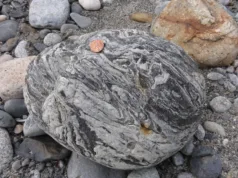Blueschist is a type of metamorphic rock that forms under high-pressure, low-temperature conditions typically associated with subduction zones in tectonic plate boundaries. It is characterized by its distinctive blue color, which is attributed to the presence of minerals such as glaucophane, a blue amphibole.
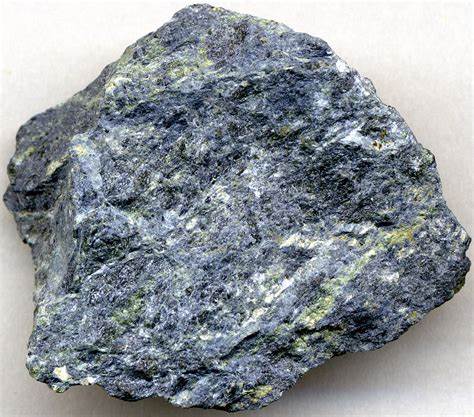
Definition and Composition: Blueschist gets its name from its blue color and the fact that it undergoes high-pressure metamorphism. The term “schist” refers to a type of metamorphic rock characterized by the alignment of mineral grains, giving it a foliated texture. Blueschist forms under conditions of high pressure, usually in subduction zones where an oceanic plate is forced beneath a continental plate. The high pressure but relatively low temperatures lead to the unique mineral assemblage characteristic of blueschist.
Explanation of Blueschist: The formation of blueschist is associated with the metamorphism of basaltic rocks in subduction zones. As the oceanic plate is subducted into the Earth’s mantle, it experiences increased pressure and lower temperatures. These conditions trigger the recrystallization of minerals in the original basaltic rock, resulting in the formation of blueschist.
The minerals present in blueschist are indicative of the specific pressure and temperature conditions under which it forms. The blue color is often due to the presence of glaucophane, a sodium-rich amphibole mineral. Other minerals commonly found in blueschist include lawsonite, jadeite, epidote, and garnet.
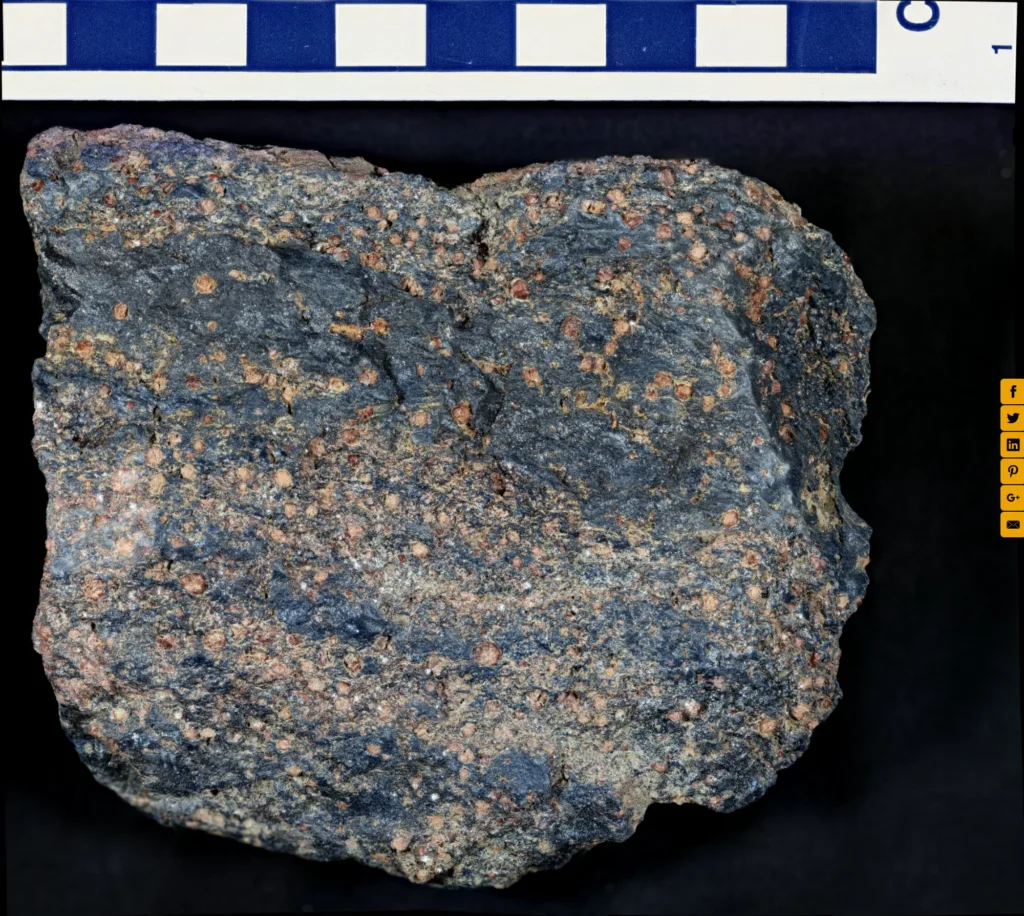
Key Minerals Present:
- Glaucophane: Glaucophane is a blue amphibole mineral and is a key indicator of blueschist facies. It is rich in sodium and is responsible for the characteristic blue color of the rock.
- Lawsonite: Lawsonite is a hydrous calcium aluminum sorosilicate mineral that commonly occurs in blueschist. It is stable under high-pressure, low-temperature conditions and contributes to the overall mineral assemblage.
- Jadeite: Jadeite is a sodium-rich pyroxene mineral often found in blueschist. It is a high-pressure, low-temperature polymorph of pyroxene and contributes to the unique mineralogy of blueschist facies.
- Epidote: Epidote is a common metamorphic mineral that may be present in blueschist. It is a calcium aluminum iron sorosilicate mineral and can form as a result of the metamorphism of basaltic rocks.
- Garnet: Garnet is another mineral that may be present in blueschist, depending on specific conditions. It is a group of silicate minerals with various compositions, and its presence can indicate the degree of metamorphism the rock has undergone.
Blueschist is important in understanding the geologic processes associated with subduction zones and provides insights into the conditions deep within the Earth’s crust where these rocks form. The distinctive mineral assemblage and blue coloration make blueschist a fascinating rock type for geologists studying the dynamic processes of plate tectonics.
Formation Process
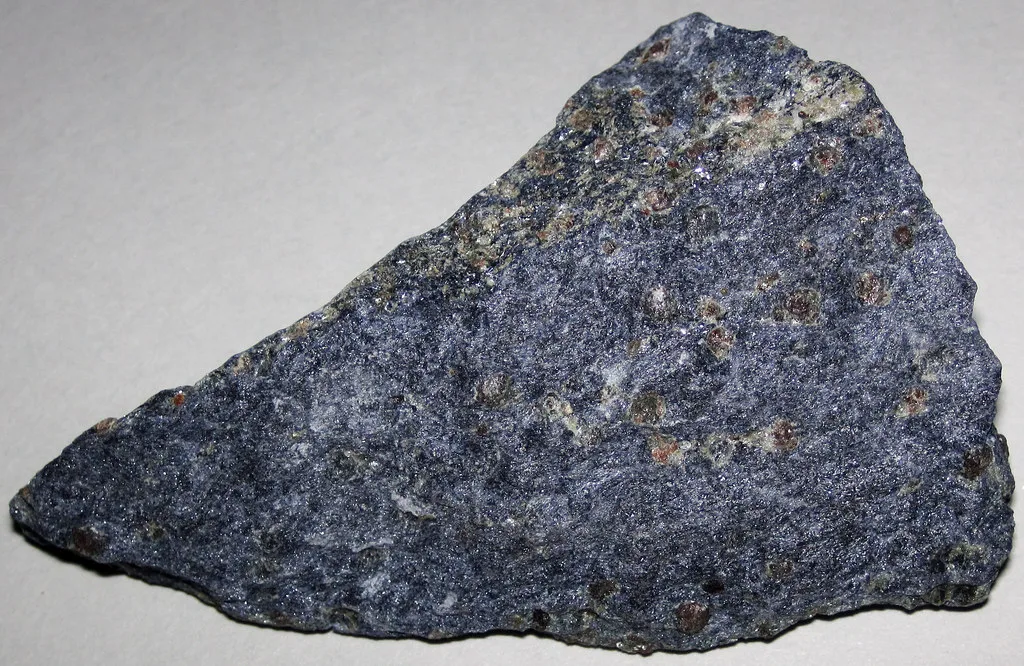
The formation of blueschist involves a complex geological process associated with the subduction of oceanic plates beneath continental plates at convergent plate boundaries. Below is a step-by-step explanation of the formation process:
- Subduction Zone Setting: Blueschist typically forms in subduction zones, where one tectonic plate is forced beneath another. In this context, an oceanic plate descends into the Earth’s mantle beneath a continental plate. As the oceanic plate descends, it encounters increasing pressure and decreasing temperature with depth.
- Metamorphism of Basaltic Rocks: Blueschist is often derived from the metamorphism of basaltic rocks, which are common components of oceanic crust. As the basaltic rocks are carried into the subduction zone, they are subjected to high-pressure conditions caused by the overlying rocks and the intense pressures associated with subduction.
- High-Pressure, Low-Temperature Conditions: Blueschist forms under specific metamorphic conditions characterized by high pressure and relatively low temperatures. The pressure can reach several kilobars, while temperatures remain lower than what is typical for many other types of metamorphic rocks.
- Recrystallization of Minerals: Under these high-pressure, low-temperature conditions, the minerals in the basaltic rocks undergo recrystallization. The original minerals transform into new ones that are stable under the given pressure-temperature conditions. This process leads to the formation of minerals such as glaucophane, lawsonite, jadeite, epidote, and garnet, which are characteristic of blueschist.
- Development of Foliated Texture: Blueschist often exhibits a foliated texture, meaning that the minerals within the rock align in a preferred orientation. This alignment is a result of the directional pressure exerted during metamorphism.
- Distinctive Blue Color: The blue color of blueschist is primarily due to the presence of glaucophane, a blue amphibole mineral. Glaucophane’s blue coloration is intensified under specific pressure-temperature conditions, contributing to the characteristic appearance of blueschist.
- Tectonic Uplift and Exhumation: Eventually, geological processes such as tectonic uplift and erosion bring the blueschist rocks back to the Earth’s surface. This exhumation allows geologists to study and observe rocks that formed deep within the Earth.
Understanding the formation of blueschist provides valuable insights into the dynamic processes occurring at convergent plate boundaries and helps researchers reconstruct the geological history of specific regions. Blueschist facies metamorphism is a crucial indicator of the subduction process and the associated changes in pressure and temperature that rocks undergo in subduction zones.
Geological Characteristics
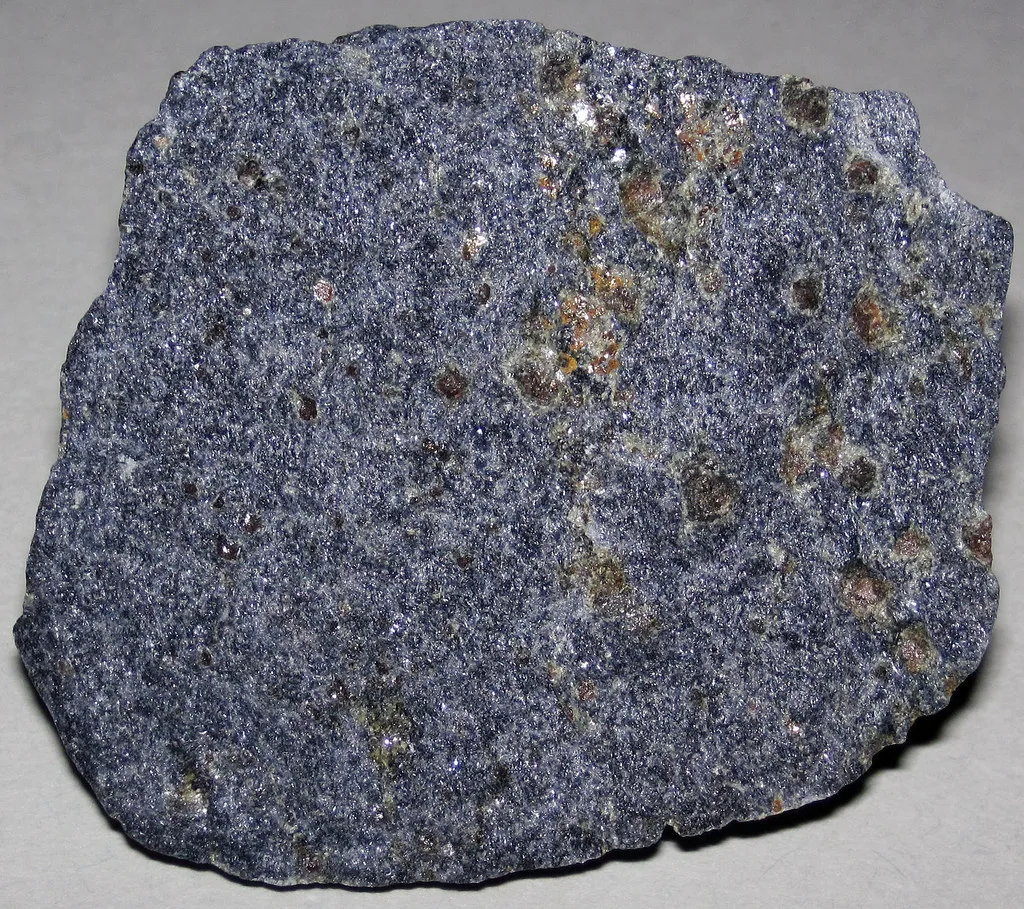
Blueschist possesses several distinctive geological characteristics that make it unique among metamorphic rocks. These characteristics are a result of the specific pressure-temperature conditions under which blueschist forms in subduction zones. Here are some key geological characteristics of blueschist:
- Mineral Assemblage: Blueschist is characterized by a specific mineral assemblage that reflects its formation under high-pressure, low-temperature conditions. Key minerals include glaucophane (a blue amphibole), lawsonite, jadeite, epidote, and garnet. These minerals indicate the unique metamorphic conditions associated with blueschist facies.
- Distinctive Blue Color: The most visually striking characteristic of blueschist is its blue color, primarily attributed to the presence of glaucophane. The intensity of the blue color is influenced by the specific pressure-temperature conditions during metamorphism.
- Foliated Texture: Blueschist often exhibits a foliated texture, meaning that its mineral grains are aligned in a preferred orientation. This alignment is a result of the directional pressure experienced during metamorphism. The foliation in blueschist is typically a result of the alignment of minerals like amphiboles and micas.
- High-Pressure, Low-Temperature Metamorphism: Blueschist facies metamorphism occurs under high-pressure conditions (ranging from several to tens of kilobars) but relatively low temperatures (typically between 200 to 500 degrees Celsius). This contrasts with other types of metamorphism, such as greenschist or amphibolite facies, which occur at higher temperatures.
- Association with Subduction Zones: Blueschist is commonly associated with subduction zones, where an oceanic plate is forced beneath a continental plate. The high-pressure conditions necessary for blueschist formation are typically found at subduction zones, making it a key indicator of past or present subduction processes.
- Presence of Index Minerals: Blueschist is associated with specific index minerals that are indicative of its unique metamorphic conditions. These minerals, including glaucophane, lawsonite, and jadeite, serve as key indicators for geologists studying metamorphic rocks to identify the pressure-temperature conditions under which the rocks formed.
- Tectonic Uplift and Exhumation: Blueschist is often exposed at the Earth’s surface through tectonic uplift and erosional processes. The discovery and study of blueschist outcrops provide valuable insights into the geological history of a region, helping geologists understand the tectonic processes that have shaped the Earth’s crust.
Understanding these geological characteristics allows geologists to interpret the tectonic history and processes that occurred in a particular region. Blueschist serves as a geological indicator of subduction-related metamorphism, contributing to our understanding of plate tectonics and the dynamic interactions between Earth’s lithospheric plates.
Field Identification
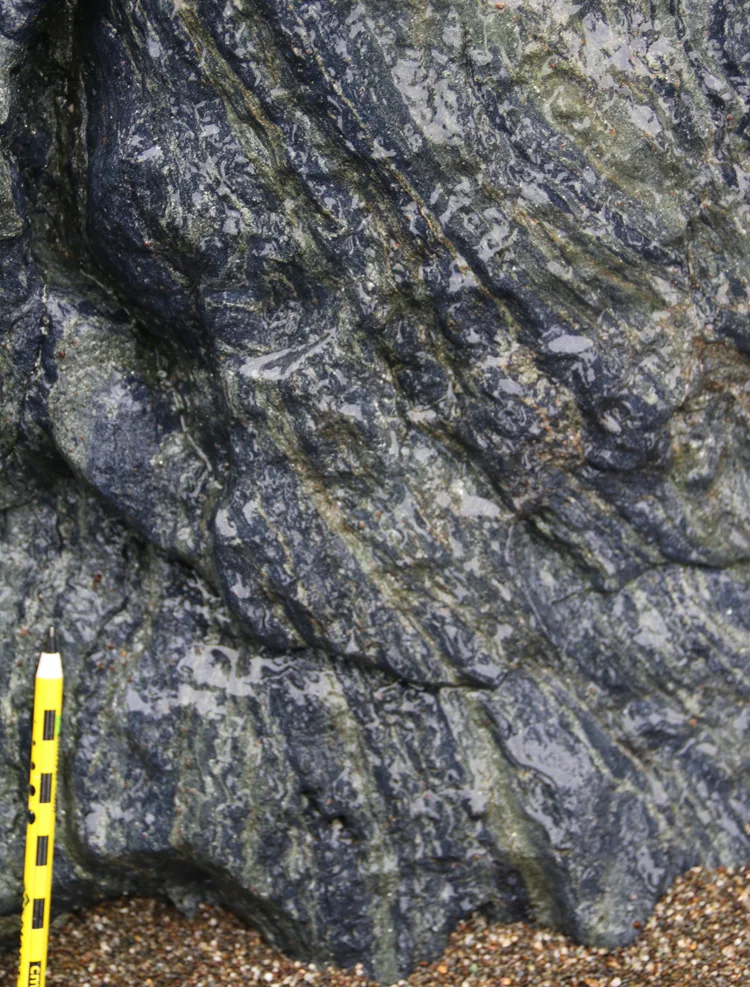
Field identification of blueschist involves recognizing its distinctive geological features and mineralogy. Geologists use a combination of visual observations, mineral identification, and knowledge of the regional geological context to identify blueschist in the field. Here are some key field identification criteria:
- Color: Blueschist is named for its characteristic blue color, which is often quite intense. While the exact shade of blue can vary, the presence of a prominent blue hue is a key visual identifier. This color is primarily due to the presence of glaucophane, a blue amphibole mineral.
- Mineralogy: Identify key minerals associated with blueschist, including glaucophane, lawsonite, jadeite, epidote, and garnet. Glaucophane’s distinctive blue color is particularly noteworthy. Lawsonite may appear as colorless to white, and jadeite may have a greenish tint.
- Foliation: Blueschist often exhibits a foliated texture, meaning that the minerals within the rock are aligned in a preferred orientation. This alignment results from the directional pressure experienced during metamorphism. Look for the foliated structure, which may appear as aligned mineral bands or streaks.
- Associations with Other Rocks: Consider the geological context and the rocks in the surrounding area. Blueschist is commonly associated with subduction zones, so look for signs of tectonic activity such as nearby volcanic rocks or evidence of plate subduction.
- Hardness: Test the hardness of the rock using a geological hammer or another tool. Blueschist is generally harder than sedimentary rocks but may not be as hard as some granitic rocks. It falls within the intermediate range of hardness.
- Density: Blueschist tends to have a higher density compared to unmetamorphosed rocks. However, field geologists may not have the means to directly measure density, so other characteristics are often relied upon for identification.
- Location and Regional Geological Setting: Consider the broader geological context of the area. Blueschist is typically found in regions with evidence of past or ongoing subduction. Look for geological features such as mountain ranges, deep-sea trenches, or other indicators of tectonic plate interactions.
- Field Guides and Maps: Consult geological field guides, maps, or regional geological surveys that provide information about the rock types and structures in the area. These resources can aid in identifying blueschist and understanding its geological significance.
It’s important to note that field identification can be challenging, and sometimes additional laboratory analyses may be needed for confirmation. Additionally, variations in mineral composition and specific geological settings can result in different appearances of blueschist. Field geologists often rely on a combination of these characteristics to make accurate identifications in the diverse and dynamic field environments where blueschist is found.
Mineralogy of Blueschist
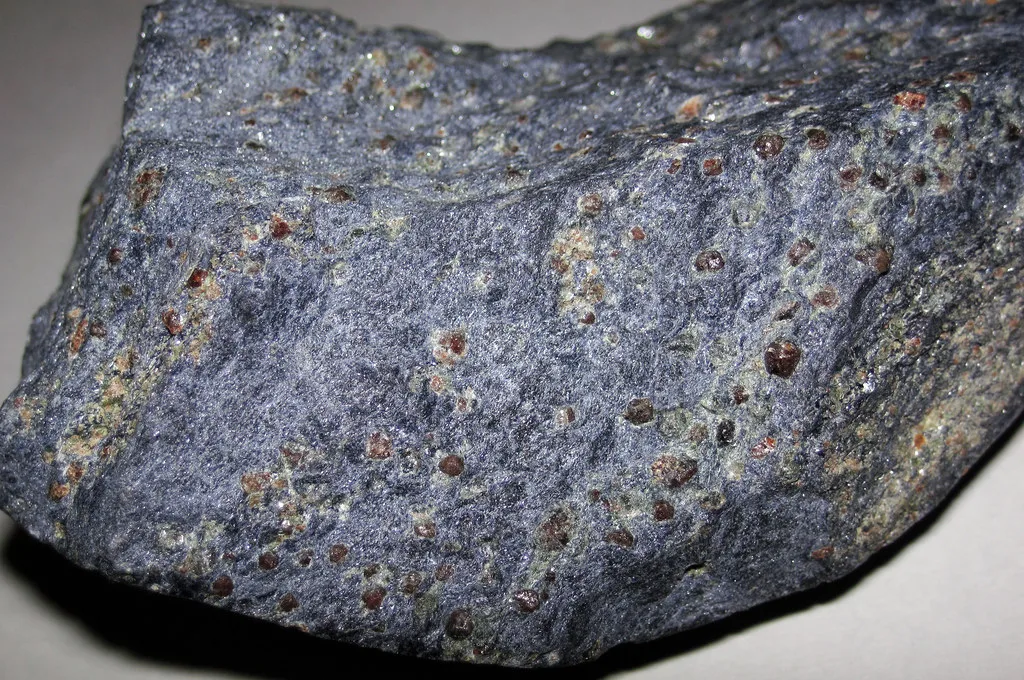
The mineralogy of blueschist is characterized by a specific assemblage of minerals that form under high-pressure, low-temperature metamorphic conditions typically associated with subduction zones. The key minerals in blueschist include:
- Glaucophane:
- Glaucophane is a blue amphibole mineral and is often the dominant mineral in blueschist, giving the rock its characteristic blue color.
- It is a sodium-rich amphibole and forms under high-pressure, low-temperature conditions.
- Lawsonite:
- Lawsonite is a hydrous calcium aluminum sorosilicate mineral commonly found in blueschist.
- It forms in the presence of water and contributes to the overall mineral assemblage of blueschist facies.
- Jadeite:
- Jadeite is a sodium-rich pyroxene mineral that is stable under high-pressure conditions.
- It is one of the key indicators of blueschist facies metamorphism.
- Epidote:
- Epidote is a calcium aluminum iron sorosilicate mineral that is commonly present in blueschist.
- It forms as a result of the metamorphism of basaltic rocks and contributes to the overall mineralogy of blueschist.
- Garnet:
- Garnet is a group of silicate minerals with various compositions, and specific types of garnet may be present in blueschist.
- The presence of garnet can provide information about the degree of metamorphism the rock has undergone.
- Albite:
- Albite is a plagioclase feldspar mineral that may be present in blueschist.
- It is a sodium-rich feldspar and contributes to the overall mineral composition.
- Chlorite:
- Chlorite is a green, iron-rich mineral that may occur in blueschist.
- It is often a secondary mineral formed during metamorphism.
- Rutile:
- Rutile, a titanium dioxide mineral, may be present in blueschist as well.
- It can occur as elongated crystals and is stable under high-pressure conditions.
- Stilpnomelane:
- Stilpnomelane is a dark brown to black amphibole mineral that may be found in some blueschist occurrences.
- Its presence can be indicative of specific chemical conditions during metamorphism.
The mineralogy of blueschist is distinctive and serves as a key indicator of the high-pressure, low-temperature metamorphic conditions associated with subduction zones. The specific combination of these minerals provides valuable information about the geological history and tectonic processes that have affected the rocks in a given region.


























